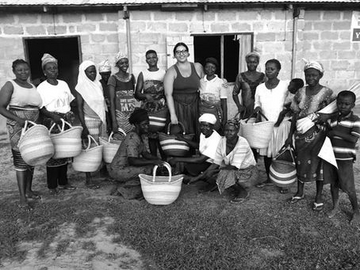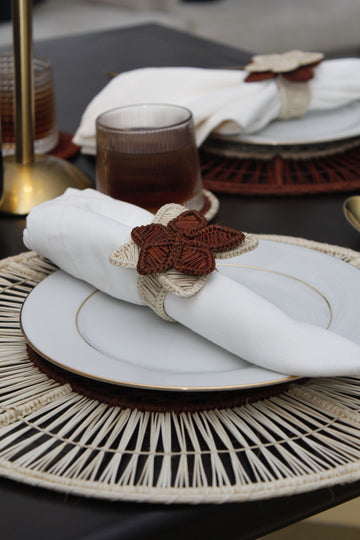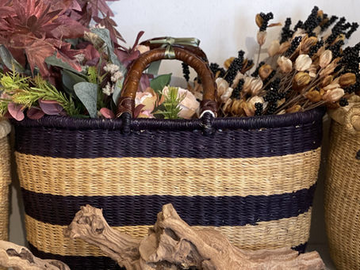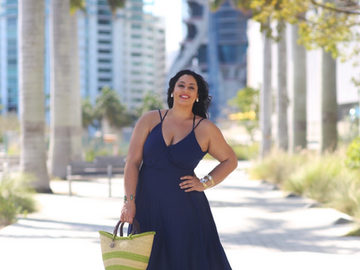When I first went to Ghana, I went believing that I was going to meet a supplier that was ready to scale. I assumed that I was going to visit a facility that had computers, printers, a storage space, packing materials, and all of the business basics.
What greeted me when I arrived at their "Weaving Centre" was , well, blighted at best- especially to my privileged, western world, American standards and expectations.
At first, it was truly emotionally shocking. These folks had little to nothing compared to my normal way of life. I walked around the center with a straight face but a very heavy heart. All I could think about was how in the world can I launch a luxury brand when the people who make the goods are working in these conditions? I wanted this business, Sonder and Holliday, to serve as a solution for these inhumane working conditions, not finance it!
"How in the world can I launch a luxury brand when the people who make the goods are working in the conditions?"

The Team in Bolgatanga, Ghana
My next thought was how? How was I going to fix this? After all, we were not a charity nor did we want to be one or involve ourselves with one. And ultimately, this is their business and they are the ones who should be responsible for their working conditions, right?
For some reason, that last bit felt wrong to think. It felt wrong to move forward with the thought that they could pull themselves out of this hole after seeing with my own two eyes how little they had as people and the lack of resources and investment from both the private sector and the government. These folks were left out of the progress the rest of the developed world enjoyed. I saw an opportunity to make a lot of money and create a successful business, but first, I needed to fix this and that was going to be a very costly endeavor.
It was a clash of capitalism 101 & doing the right (much harder) thing.
Upon returning to MIami, I presented Victoria with all of the info I gathered while I was there. She too felt the strain of the idea of building a luxury brand without somehow uplifting the folks who make the goods. ( Fun fact- she coined our slogan: True Luxury Uplifts the Wearer and the Maker during that call).
And this went beyond paying them fairly. This meant we were going to have to implement some sort of give back component without being a charity. But at the same time, shouldering the cost of rebuilding such a large place was impossible to bear as a small business, especially once we hit the pandemic years.
"It was a clash of capitalism 101 & doing the right (much harder) thing."
Together, we figured that the best way to truly create a profound impact was to handle the reinvestment ourselves and form a privately funded effort. But, this effort needed to be in partnership with the artisans so that they would feel the empowerment of knowing that this change came because of them, not because two white Americans "gave" them something .
(Even though Victoria and I both consider ourselves to be of mixed ethnicities, in those parts, you are either black or white, so to them, we are white women.)
That is where we came up with the idea of The Victoria Project.

Goofing around with Sammy, the 10 year old photographer, who took this photo because I was barefoot on the "ugly" floor of the Center.
The Victoria Project is our privately funded program developed to reinvest in the communities we source from by dedicating a portion of our sales to bettering the working conditions of the makers who craft our goods. Aside from rebuilding their center, we also offer a soap program incentive where each weaver receives soap for themselves and their families. In addition to this, we also purchased many materials for them to remain COVID19 compliant as well as other miscellaneous items like gloves, mats, pots, wood, and pigments they may need that make working at the center easier.
But, we never offer anything without some sort of partnership. If we buy the wood, pots, and pigments, they have to pay for the person who will dye the straw. If they want appliances, they will need to cover the cost of center's electricity bill. If they want tablets , they need to pay for their own Wifi.
The idea was that we helped ensure that the strings they pulled were attached to sturdy boots.

The Weaving Center after the walls were raised and the floors elevated, before the roof replacement
However, our biggest goal is and always was the renovation of the centre. These weavers deserve to work in a place that feels prestigeous and respectful of their abilities and skills. Instead, the center looks like a physical manifestation of what they have been told their entire life via societal ques: the best you can do is weave and that is because you are poor and uneducated and unworthy of an opportunity for advancment.
We set out to change that story for them, brick by brick.
I'll tell you more about it on my next post!
Lorena





